2006 DODGE RAM SRT-10 Fuel injector removal
[x] Cancel search: Fuel injector removalPage 2336 of 5267
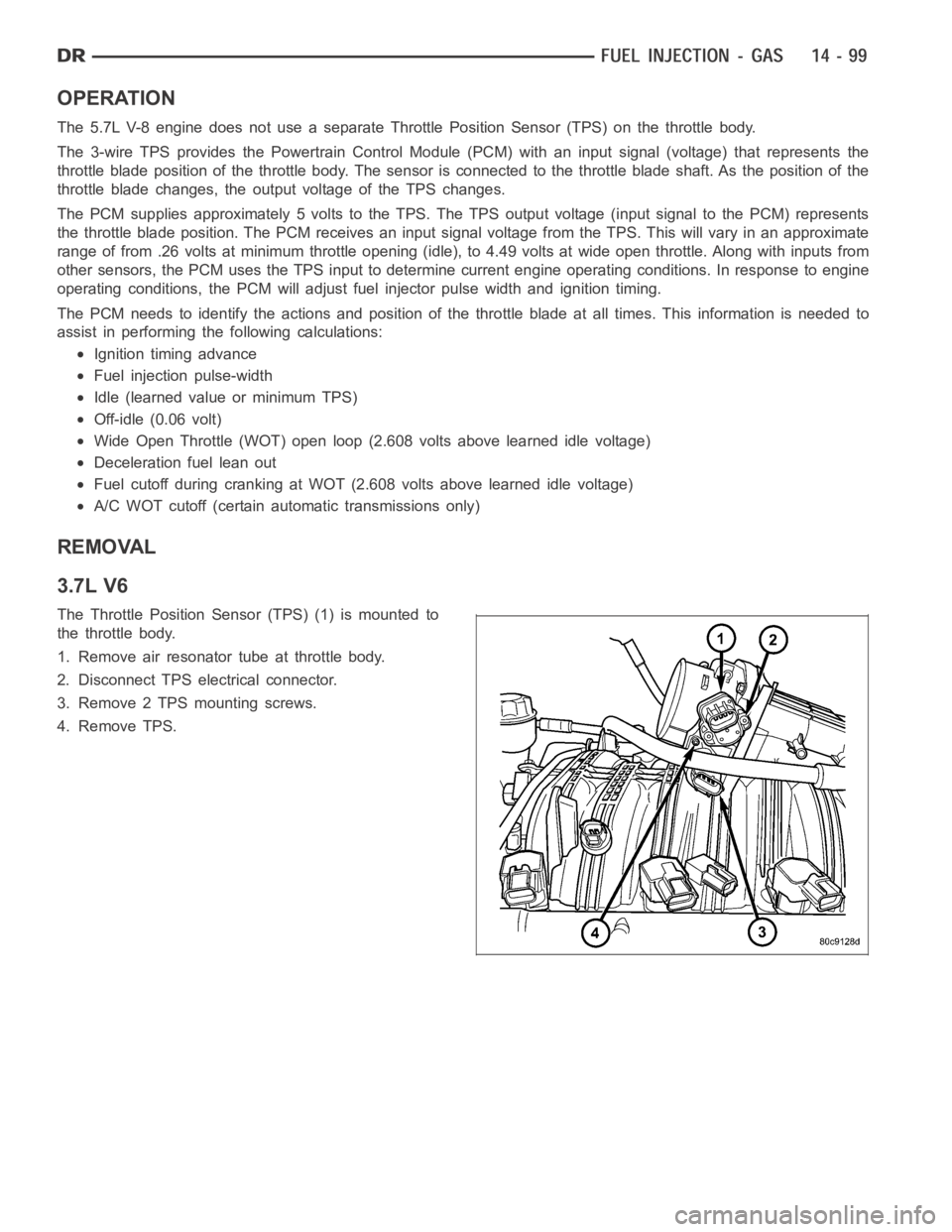
OPERATION
The 5.7L V-8 engine does not use a separate Throttle Position Sensor (TPS) on the throttle body.
The 3-wire TPS provides the Powertrain Control Module (PCM) with an input signal (voltage) that represents the
throttle blade position of the throttle body. The sensor is connected to the throttle blade shaft. As the position of the
throttle blade changes, the output voltage of the TPS changes.
The PCM supplies approximately 5 volts to the TPS. The TPS output voltage (input signal to the PCM) represents
the throttle blade position. The PCM receives an input signal voltage fromthe TPS. This will vary in an approximate
range of from .26 volts at minimum throttle opening (idle), to 4.49 volts atwide open throttle. Along with inputs from
other sensors, the PCM uses the TPS input to determine current engine operating conditions. In response to engine
operating conditions, the PCM will adjust fuel injector pulse width and ignition timing.
The PCM needs to identify the actions and position of the throttle blade at all times. This information is needed to
assist in performing the following calculations:
Ignition timing advance
Fuel injection pulse-width
Idle (learned value or minimum TPS)
Off-idle (0.06 volt)
Wide Open Throttle (WOT) open loop (2.608 volts above learned idle voltage)
Deceleration fuel lean out
Fuel cutoff during cranking at WOT (2.608 volts above learned idle voltage)
A/C WOT cutoff (certain automatic transmissions only)
REMOVAL
3.7L V6
The Throttle Position Sensor (TPS) (1) is mounted to
the throttle body.
1. Remove air resonator tube at throttle body.
2. Disconnect TPS electrical connector.
3. Remove 2 TPS mounting screws.
4. Remove TPS.
Page 2341 of 5267
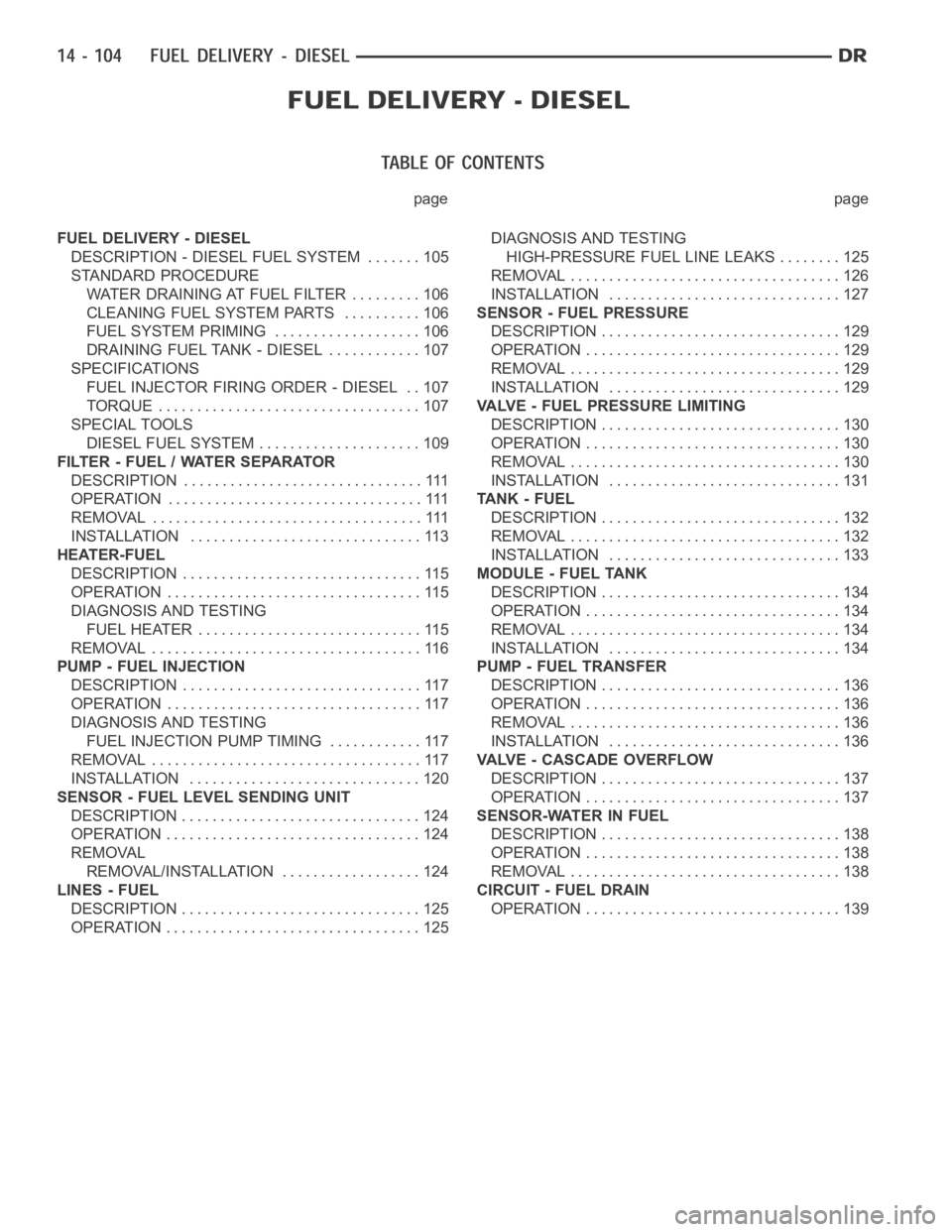
page page
FUEL DELIVERY - DIESEL
DESCRIPTION - DIESEL FUEL SYSTEM ....... 105
STANDARD PROCEDURE
WATER DRAINING AT FUEL FILTER ......... 106
CLEANING FUEL SYSTEM PARTS .......... 106
FUEL SYSTEM PRIMING................... 106
DRAINING FUEL TANK - DIESEL............ 107
SPECIFICATIONS
FUEL INJECTOR FIRING ORDER - DIESEL . . 107
TORQUE .................................. 107
SPECIAL TOOLS
DIESEL FUEL SYSTEM . .................... 109
FILTER - FUEL / WATER SEPARATOR
DESCRIPTION ............................... 111
OPERATION ................................. 111
REMOVAL ................................... 111
INSTALLATION .............................. 113
HEATER-FUEL
DESCRIPTION ............................... 115
OPERATION ................................. 115
DIAGNOSIS AND TESTING
FUEL HEATER ............................. 115
REMOVAL ................................... 116
PUMP - FUEL INJECTION
DESCRIPTION ............................... 117
OPERATION ................................. 117
DIAGNOSIS AND TESTING
FUEL INJECTION PUMP TIMING ............ 117
REMOVAL ................................... 117
INSTALLATION .............................. 120
SENSOR - FUEL LEVEL SENDING UNIT
DESCRIPTION ............................... 124
OPERATION ................................. 124
REMOVAL
REMOVAL/INSTALLATION .................. 124
LINES - FUEL
DESCRIPTION ............................... 125
OPERATION ................................. 125DIAGNOSIS AND TESTING
HIGH-PRESSURE FUEL LINE LEAKS........ 125
REMOVAL ................................... 126
INSTALLATION .............................. 127
SENSOR - FUEL PRESSURE
DESCRIPTION ............................... 129
OPERATION ................................. 129
REMOVAL ................................... 129
INSTALLATION .............................. 129
VALVE - FUEL PRESSURE LIMITING
DESCRIPTION ............................... 130
OPERATION ................................. 130
REMOVAL ................................... 130
INSTALLATION .............................. 131
TA N K - F U E L
DESCRIPTION ............................... 132
REMOVAL ................................... 132
INSTALLATION .............................. 133
MODULE - FUEL TANK
DESCRIPTION ............................... 134
OPERATION ................................. 134
REMOVAL ................................... 134
INSTALLATION .............................. 134
PUMP - FUEL TRANSFER
DESCRIPTION ............................... 136
OPERATION ................................. 136
REMOVAL ................................... 136
INSTALLATION .............................. 136
VALVE - CASCADE OVERFLOW
DESCRIPTION ............................... 137
OPERATION ................................. 137
SENSOR-WATER IN FUEL
DESCRIPTION ............................... 138
OPERATION ................................. 138
REMOVAL ................................... 138
CIRCUIT - FUEL DRAIN
OPERATION ................................. 139
Page 2343 of 5267
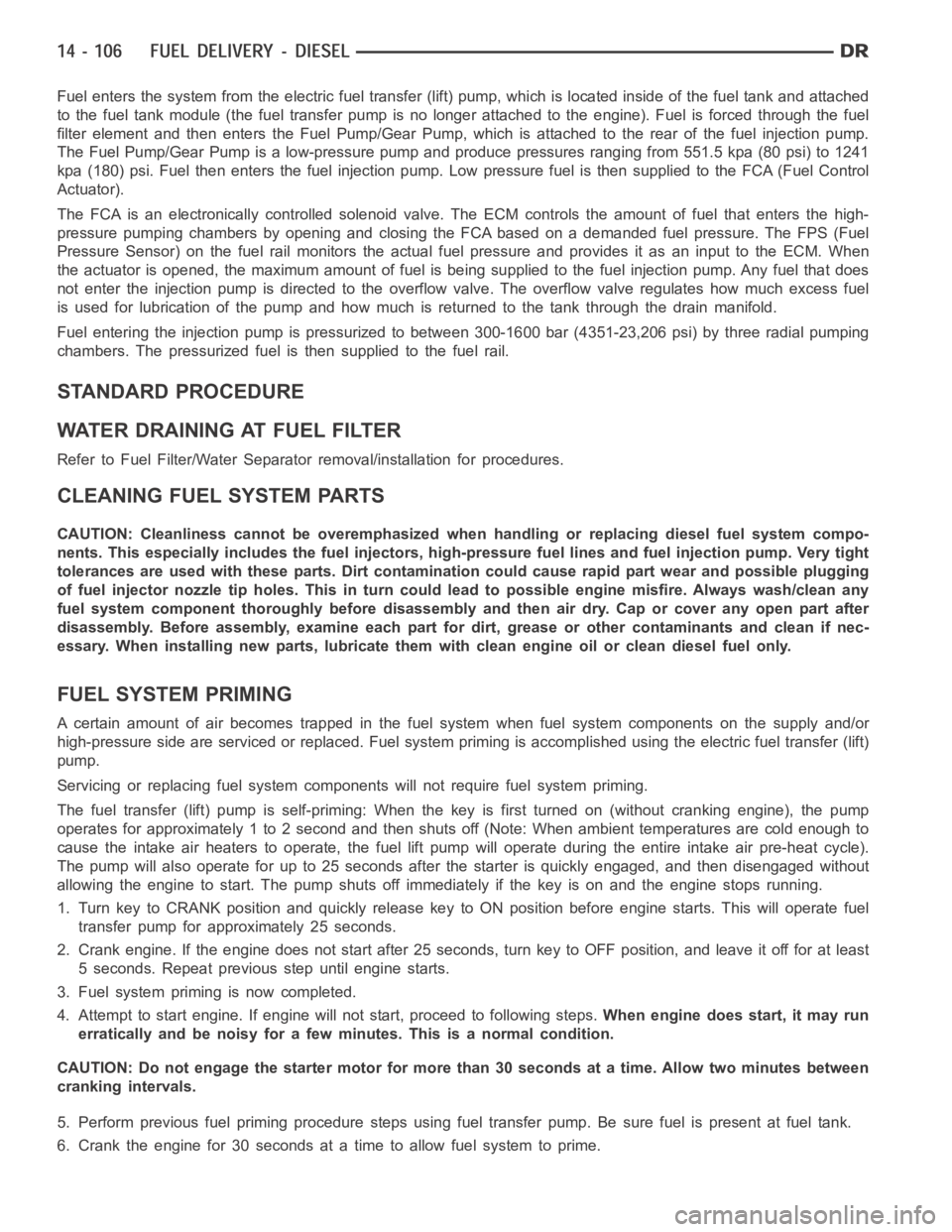
Fuel enters the system from the electric fuel transfer (lift) pump, which is located inside of the fuel tank and attached
to the fuel tank module (the fuel transfer pump is no longer attached to the engine). Fuel is forced through the fuel
filter element and then enters the Fuel Pump/Gear Pump, which is attached to the rear of the fuel injection pump.
The Fuel Pump/Gear Pump is a low-pressure pump and produce pressures ranging from 551.5 kpa (80 psi) to 1241
kpa (180) psi. Fuel then enters the fuel injection pump. Low pressure fuel is then supplied to the FCA (Fuel Control
Actuator).
The FCA is an electronically controlled solenoid valve. The ECM controls the amount of fuel that enters the high-
pressure pumping chambers by opening and closing the FCA based on a demanded fuel pressure. The FPS (Fuel
Pressure Sensor) on the fuel rail monitors the actual fuel pressure and provides it as an input to the ECM. When
the actuator is opened, the maximum amount of fuel is being supplied to the fuel injection pump. Any fuel that does
not enter the injection pump is directed to the overflow valve. The overflow valve regulates how much excess fuel
is used for lubrication of the pump and how much is returned to the tank through the drain manifold.
Fuel entering the injection pump is pressurized to between 300-1600 bar (4351-23,206 psi) by three radial pumping
chambers. The pressurized fuel is then supplied to the fuel rail.
STANDARD PROCEDURE
WATER DRAINING AT FUEL FILTER
Refer to Fuel Filter/Water Separatorremoval/installation for procedures.
CLEANING FUEL SYSTEM PARTS
CAUTION: Cleanliness cannot be overemphasized when handling or replacingdieselfuelsystemcompo-
nents. This especially includes the fuel injectors, high-pressure fuel lines and fuel injection pump. Very tight
tolerances are used with these parts. Dirt contamination could cause rapid part wear and possible plugging
of fuel injector nozzle tip holes. This in turn could lead to possible engine misfire. Always wash/clean any
fuel system component thoroughly before disassembly and then air dry. Capor cover any open part after
disassembly. Before assembly, examine each part for dirt, grease or othercontaminants and clean if nec-
essary. When installing new parts, lubricate them with clean engine oil orclean diesel fuel only.
FUEL SYSTEM PRIMING
A certain amount of air becomes trappedin the fuel system when fuel system components on the supply and/or
high-pressure side are serviced or replaced. Fuel system priming is accomplished using the electric fuel transfer (lift)
pump.
Servicing or replacing fuel system components will not require fuel systempriming.
The fuel transfer (lift) pump is self-priming: When the key is first turnedon (without cranking engine), the pump
operates for approximately 1 to 2 second and then shuts off (Note: When ambient temperatures are cold enough to
cause the intake air heaters to operate, the fuel lift pump will operate during the entire intake air pre-heat cycle).
The pump will also operate for up to 25 seconds after the starter is quickly engaged, and then disengaged without
allowing the engine to start. The pump shuts off immediately if the key is onand the engine stops running.
1. Turn key to CRANK position and quickly release key to ON position before engine starts. This will operate fuel
transfer pump for approximately 25 seconds.
2. Crank engine. If the engine does not start after 25 seconds, turn key to OFF position, and leave it off for at least
5 seconds. Repeat previous step until engine starts.
3. Fuel system priming is now completed.
4. Attempt to start engine. If engine will not start, proceed to following steps.When engine does start, it may run
erratically and be noisy for a few minutes. This is a normal condition.
CAUTION: Do not engage the starter motor for more than 30 seconds at a time. Allow two minutes between
cranking intervals.
5. Perform previous fuel priming procedure steps using fuel transfer pump. Be sure fuel is present at fuel tank.
6. Crank the engine for 30 seconds at a time to allow fuel system to prime.
Page 2354 of 5267
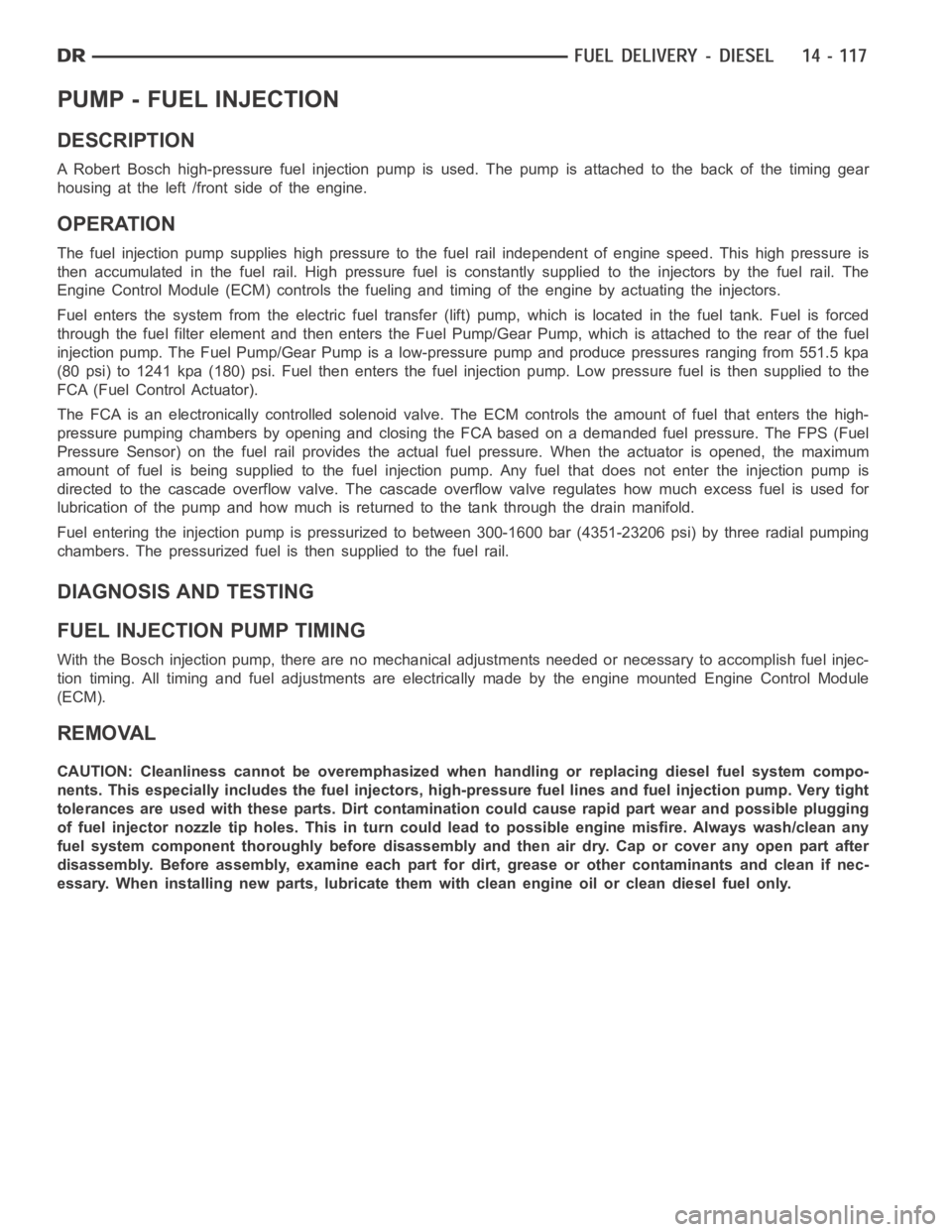
PUMP - FUEL INJECTION
DESCRIPTION
A Robert Bosch high-pressure fuel injection pump is used. The pump is attached to the back of the timing gear
housing at the left /front side of the engine.
OPERATION
The fuel injection pump supplies high pressure to the fuel rail independent of engine speed. This high pressure is
then accumulated in the fuel rail. High pressure fuel is constantly supplied to the injectors by the fuel rail. The
Engine Control Module (ECM) controls the fueling and timing of the engine by actuating the injectors.
Fuel enters the system from the electric fuel transfer (lift) pump, which is located in the fuel tank. Fuel is forced
through the fuel filter element and then enters the Fuel Pump/Gear Pump, which is attached to the rear of the fuel
injection pump. The Fuel Pump/Gear Pump is a low-pressure pump and producepressures ranging from 551.5 kpa
(80 psi) to 1241 kpa (180) psi. Fuel then enters the fuel injection pump. Lowpressure fuel is then supplied to the
FCA (Fuel Control Actuator).
The FCA is an electronically controlled solenoid valve. The ECM controls the amount of fuel that enters the high-
pressure pumping chambers by opening and closing the FCA based on a demanded fuel pressure. The FPS (Fuel
Pressure Sensor) on the fuel rail provides the actual fuel pressure. When the actuator is opened, the maximum
amount of fuel is being supplied to the fuel injection pump. Any fuel that does not enter the injection pump is
directed to the cascade overflow valve. The cascade overflow valve regulates how much excess fuel is used for
lubrication of the pump and how much is returned to the tank through the drain manifold.
Fuel entering the injection pump is pressurized to between 300-1600 bar (4351-23206 psi) by three radial pumping
chambers. The pressurized fuel is then supplied to the fuel rail.
DIAGNOSIS AND TESTING
FUEL INJECTION PUMP TIMING
With the Bosch injection pump, there are no mechanical adjustments neededor necessary to accomplish fuel injec-
tion timing. All timing and fuel adjustments are electrically made by the engine mounted Engine Control Module
(ECM).
REMOVAL
CAUTION: Cleanliness cannot be overemphasized when handling or replacingdieselfuelsystemcompo-
nents. This especially includes the fuel injectors, high-pressure fuel lines and fuel injection pump. Very tight
tolerances are used with these parts. Dirt contamination could cause rapid part wear and possible plugging
of fuel injector nozzle tip holes. This in turn could lead to possible engine misfire. Always wash/clean any
fuel system component thoroughly before disassembly and then air dry. Capor cover any open part after
disassembly. Before assembly, examine each part for dirt, grease or othercontaminants and clean if nec-
essary. When installing new parts, lubricate them with clean engine oil orclean diesel fuel only.
Page 2363 of 5267
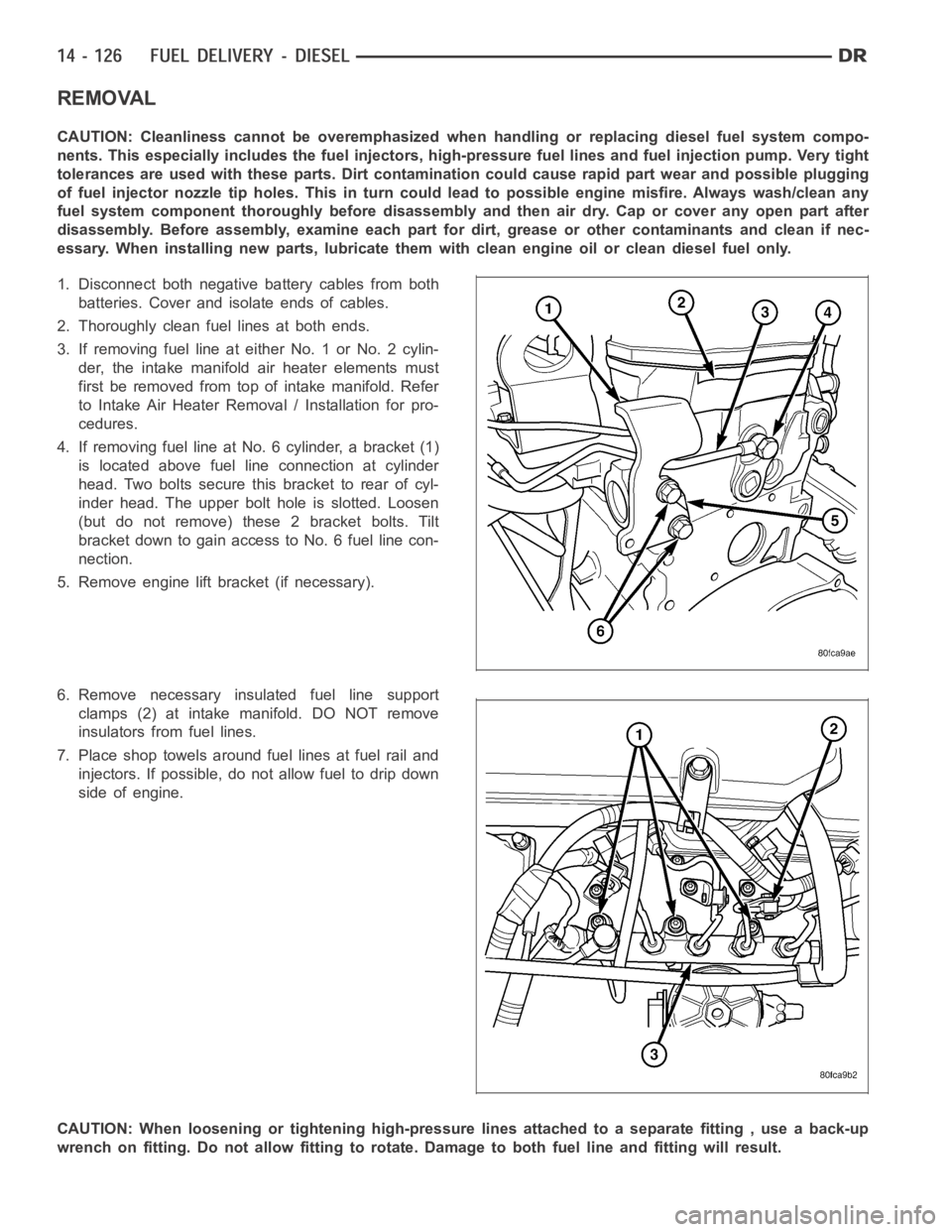
REMOVAL
CAUTION: Cleanliness cannot be overemphasized when handling or replacingdieselfuelsystemcompo-
nents. This especially includes the fuel injectors, high-pressure fuel lines and fuel injection pump. Very tight
tolerances are used with these parts. Dirt contamination could cause rapid part wear and possible plugging
of fuel injector nozzle tip holes. This in turn could lead to possible engine misfire. Always wash/clean any
fuel system component thoroughly before disassembly and then air dry. Capor cover any open part after
disassembly. Before assembly, examine each part for dirt, grease or othercontaminants and clean if nec-
essary. When installing new parts, lubricate them with clean engine oil orclean diesel fuel only.
1. Disconnect both negative battery cables from both
batteries. Cover and isolate ends of cables.
2. Thoroughly clean fuel lines at both ends.
3. If removing fuel line at either No. 1 or No. 2 cylin-
der, the intake manifold air heater elements must
first be removed from top of intake manifold. Refer
to Intake Air Heater Removal / Installation for pro-
cedures.
4. If removing fuel line at No. 6 cylinder, a bracket (1)
is located above fuel line connection at cylinder
head. Two bolts secure this bracket to rear of cyl-
inder head. The upper bolt hole is slotted. Loosen
(but do not remove) these 2 bracket bolts. Tilt
bracket down to gain access to No. 6 fuel line con-
nection.
5. Remove engine lift bracket (if necessary).
6. Remove necessary insulated fuel line support
clamps (2) at intake manifold. DO NOT remove
insulators from fuel lines.
7. Place shop towels around fuel lines at fuel rail and
injectors. If possible, do not allow fuel to drip down
side of engine.
CAUTION: When loosening or tightening high-pressure lines attached to a separate fitting , use a back-up
wrench on fitting. Do not allow fitting to rotate. Damage to both fuel line and fitting will result.
Page 2367 of 5267
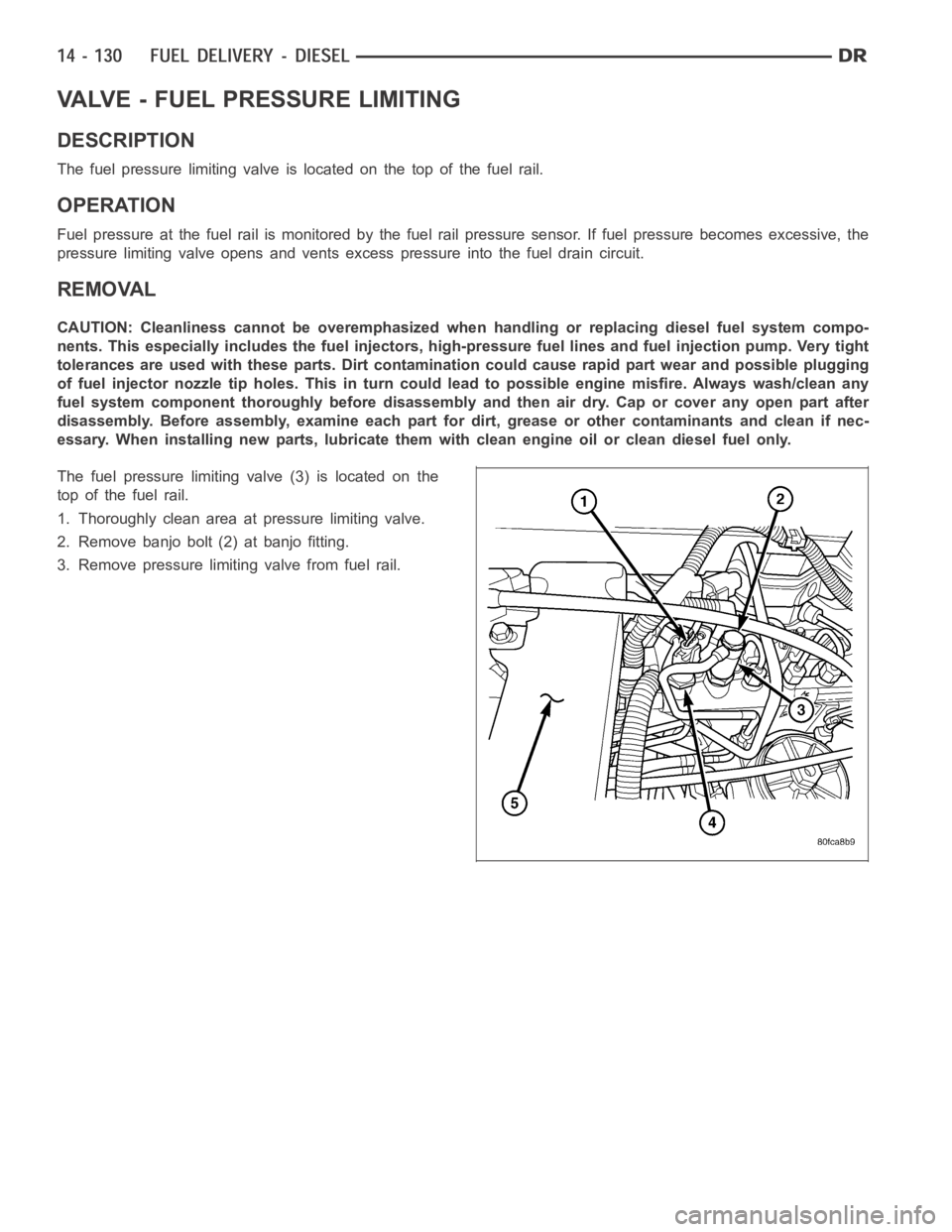
VALVE - FUEL PRESSURE LIMITING
DESCRIPTION
The fuel pressure limiting valve is located on the top of the fuel rail.
OPERATION
Fuel pressure at the fuel rail is monitored by the fuel rail pressure sensor. If fuel pressure becomes excessive, the
pressure limiting valve opens and vents excess pressure into the fuel draincircuit.
REMOVAL
CAUTION: Cleanliness cannot be overemphasized when handling or replacingdieselfuelsystemcompo-
nents. This especially includes the fuel injectors, high-pressure fuel lines and fuel injection pump. Very tight
tolerances are used with these parts. Dirt contamination could cause rapid part wear and possible plugging
of fuel injector nozzle tip holes. This in turn could lead to possible engine misfire. Always wash/clean any
fuel system component thoroughly before disassembly and then air dry. Capor cover any open part after
disassembly. Before assembly, examine each part for dirt, grease or othercontaminants and clean if nec-
essary. When installing new parts, lubricate them with clean engine oil orclean diesel fuel only.
The fuel pressure limiting valve (3) is located on the
top of the fuel rail.
1. Thoroughly clean area at pressure limiting valve.
2. Remove banjo bolt (2) at banjo fitting.
3. Remove pressure limiting valve from fuel rail.
Page 2373 of 5267
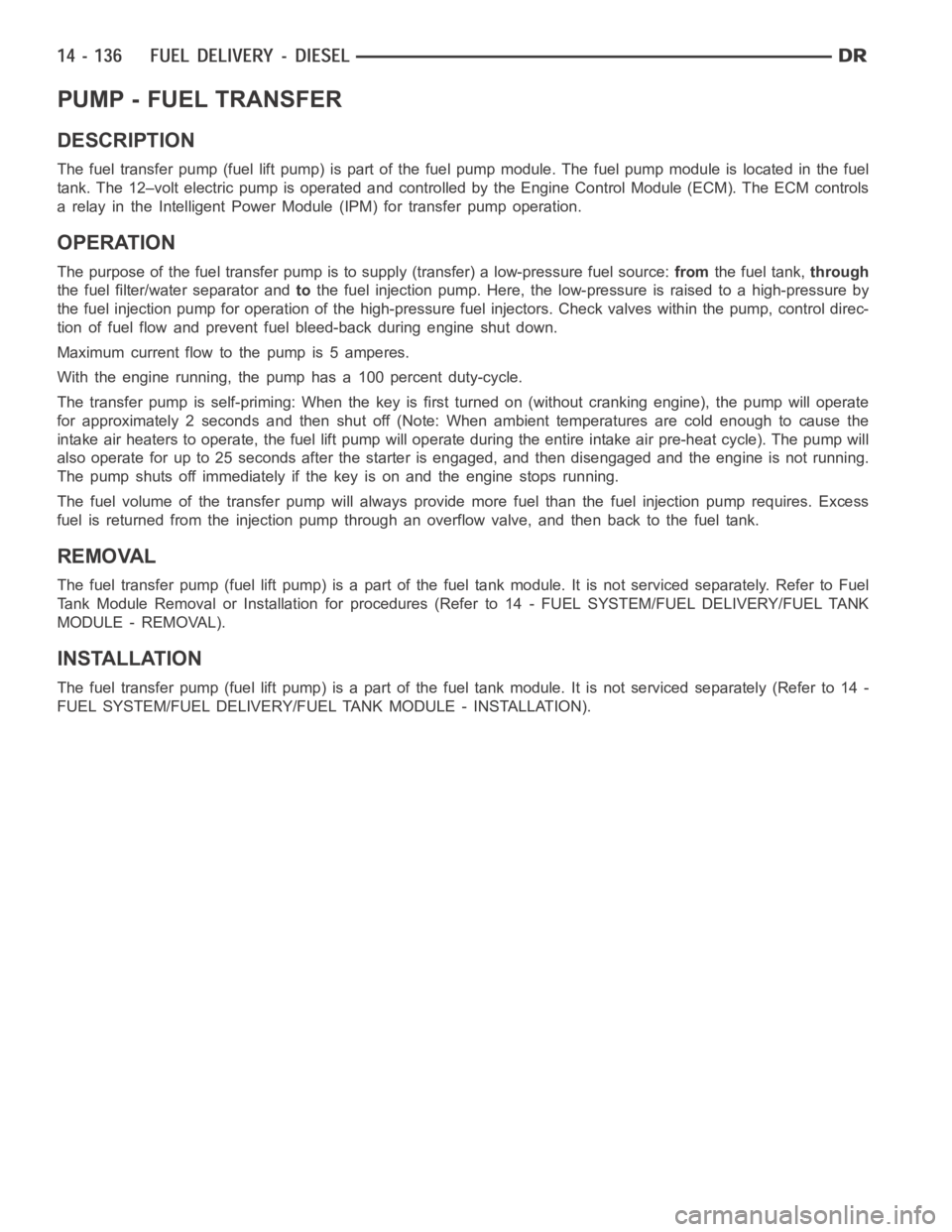
PUMP - FUEL TRANSFER
DESCRIPTION
The fuel transfer pump (fuel lift pump) is part of the fuel pump module. The fuel pump module is located in the fuel
tank. The 12–volt electric pump is operated and controlled by the Engine Control Module (ECM). The ECM controls
a relay in the Intelligent Power Module(IPM) for transfer pump operation.
OPERATION
The purpose of the fuel transfer pump is to supply (transfer) a low-pressure fuel source:fromthe fuel tank,through
the fuel filter/water separator andtothe fuel injection pump. Here, the low-pressure is raised to a high-pressure by
the fuel injection pump for operation of the high-pressure fuel injectors. Check valves within the pump, control direc-
tion of fuel flow and prevent fuel bleed-back during engine shut down.
Maximum current flow to the pump is 5 amperes.
With the engine running, the pump has a 100 percent duty-cycle.
The transfer pump is self-priming: When the key is first turned on (withoutcranking engine), the pump will operate
for approximately 2 seconds and then shut off (Note: When ambient temperatures are cold enough to cause the
intake air heaters to operate, the fuel lift pump will operate during the entire intake air pre-heat cycle). The pump will
also operate for up to 25 seconds after the starter is engaged, and then disengaged and the engine is not running.
The pump shuts off immediately if the key is on and the engine stops running.
The fuel volume of the transfer pump will always provide more fuel than the fuel injection pump requires. Excess
fuel is returned from the injection pump through an overflow valve, and then back to the fuel tank.
REMOVAL
The fuel transfer pump (fuel lift pump) is a part of the fuel tank module. It is not serviced separately. Refer to Fuel
Tank Module Removal or Installation for procedures (Refer to 14 - FUEL SYSTEM/FUEL DELIVERY/FUEL TANK
MODULE - REMOVAL).
INSTALLATION
The fuel transfer pump (fuel lift pump) is a part of the fuel tank module. It is not serviced separately (Refer to 14 -
FUEL SYSTEM/FUEL DELIVERY/FUEL TANK MODULE - INSTALLATION).
Page 2377 of 5267
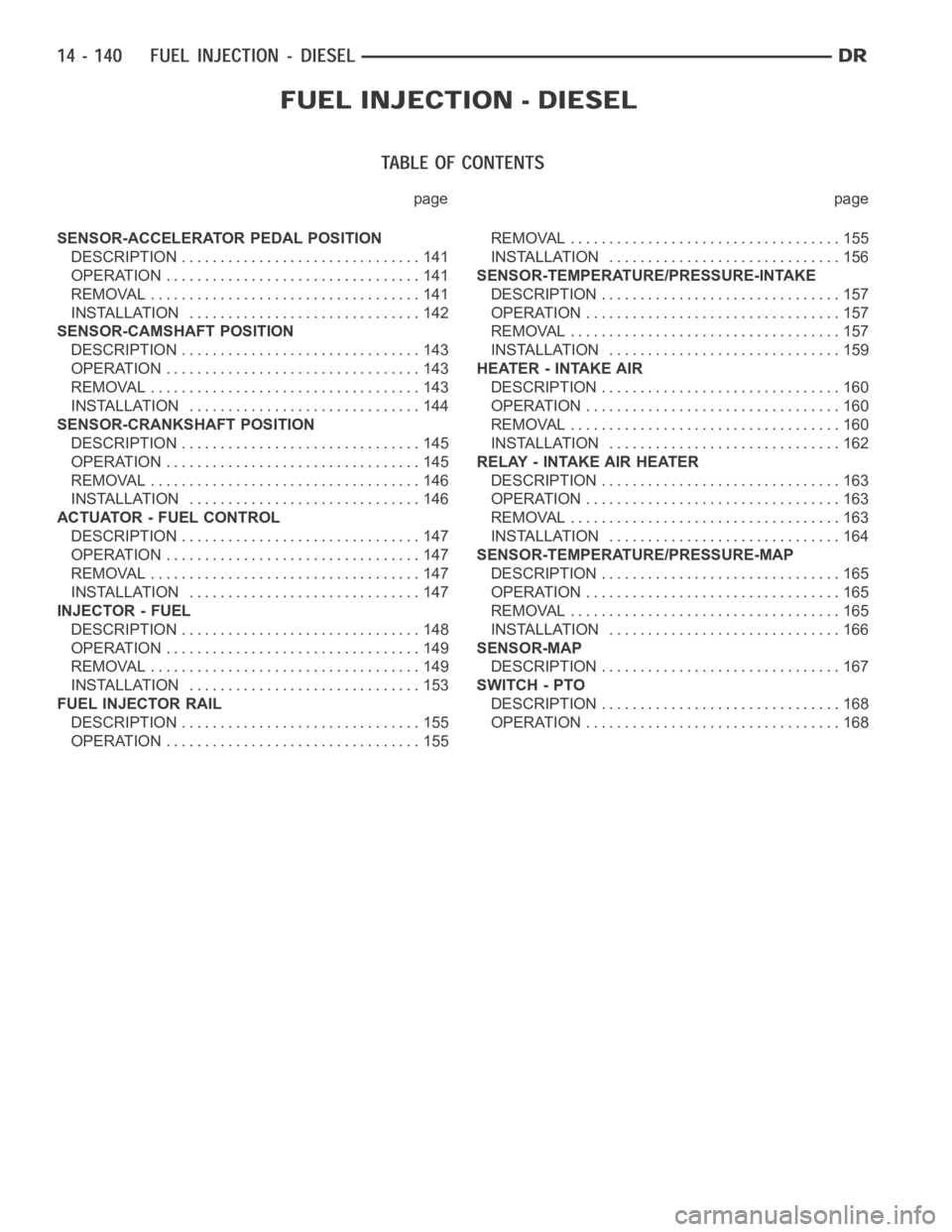
page page
SENSOR-ACCELERATOR PEDAL POSITION
DESCRIPTION ............................... 141
OPERATION ................................. 141
REMOVAL ................................... 141
INSTALLATION .............................. 142
SENSOR-CAMSHAFT POSITION
DESCRIPTION ............................... 143
OPERATION ................................. 143
REMOVAL ................................... 143
INSTALLATION .............................. 144
SENSOR-CRANKSHAFT POSITION
DESCRIPTION ............................... 145
OPERATION ................................. 145
REMOVAL ................................... 146
INSTALLATION .............................. 146
ACTUATOR - FUEL CONTROL
DESCRIPTION ............................... 147
OPERATION ................................. 147
REMOVAL ................................... 147
INSTALLATION .............................. 147
INJECTOR - FUEL
DESCRIPTION ............................... 148
OPERATION ................................. 149
REMOVAL ................................... 149
INSTALLATION .............................. 153
FUEL INJECTOR RAIL
DESCRIPTION ............................... 155
OPERATION ................................. 155REMOVAL ................................... 155
INSTALLATION .............................. 156
SENSOR-TEMPERATURE/PRESSURE-INTAKE
DESCRIPTION ............................... 157
OPERATION ................................. 157
REMOVAL ................................... 157
INSTALLATION .............................. 159
HEATER - INTAKE AIR
DESCRIPTION ............................... 160
OPERATION ................................. 160
REMOVAL ................................... 160
INSTALLATION .............................. 162
RELAY - INTAKE AIR HEATER
DESCRIPTION ............................... 163
OPERATION ................................. 163
REMOVAL ................................... 163
INSTALLATION .............................. 164
SENSOR-TEMPERATURE/PRESSURE-MAP
DESCRIPTION ............................... 165
OPERATION ................................. 165
REMOVAL ................................... 165
INSTALLATION .............................. 166
SENSOR-MAP
DESCRIPTION ............................... 167
SWITCH - PTO
DESCRIPTION ............................... 168
OPERATION ................................. 168